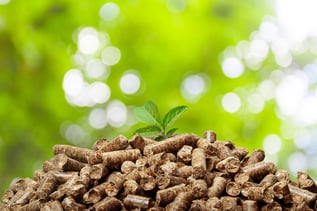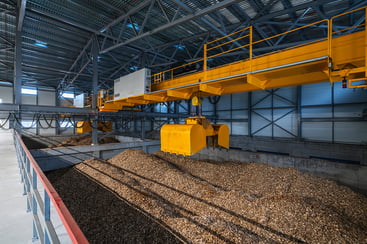Nations around the globe are looking for alternative fuels that are renewable, carbon neutral and/or can be used to break fossil fuel dependency. Switching to biomass fuel sources can help reduce greenhouse gas emissions and contribute to sustainability goals. Biomass not only provides energy and fuel, but it also can be used in the production of numerous biomaterials and biochemicals that can be used for paints, detergents, industrial adhesives, bioplastics, composite materials, cosmetics, supplements and food additives. However, the collection, processing and handling of biomass can pose unique challenges because biomass is a broad category encompassing multiple types of feedstocks with varying properties.
This means that dust collection resulting from biomass processing will require a customized approach. This blog post outlines several reasons this approach is necessary and how working with an experienced dust collection equipment provider like Sly, LLC can supply the right solution to overcome biomass dust collection challenges. 
What are examples of biomass feedstocks?
Biomass feedstocks refer to organic materials that generate energy or are used to produce products through various processes such as combustion, gasification, fermentation and other techniques. A variety of sources supply biomass feedstock, some of these sources are as follows:
- Wood processing (i.e., wood chips, sawdust, bark, branches, leaves/needles, etc.)
- Agricultural waste (i.e., ranging from straw and corn stover to manure from livestock operations)
- Dedicated energy crops (plants grown specifically for energy production, such as switchgrass)
- Municipal solid waste (such as cardboard, paper, textiles, food waste, etc.)
- Algae (grown in ponds or tanks and harvested for energy production or other products)
- Food Waste
Biomass challenges energy operations and other manufacturing processes because of its varying properties and the fact that some sources are seasonal and unavailable all year. In addition, the environmental systems that deal with biomass for dust collection, acid gas removal or odor control need to consider all these factors for a design that optimizes system removal efficiency and overall performance. These factors include:
- Feedstock variability. Biomass feedstocks can vary significantly in terms of both physical and chemical properties, such as size, shape, density, moisture content and composition. Even within the same “family” of biomass types such as wood chips and sawdust, which both originally come from a tree, you can have different properties and require other handling methods. This variability is the primary reason why biomass dust collection requires a customized approach.
- Potential combustibility. Any explosion risk is related to the material characteristics, particle size, concentration, moisture content and oxygen availability. Biomass dust used for energy production or other processes can also pose an explosion risk due to its potential combustibility from the dried source. In this case, a “customized” approach means adding practical safeguards necessary to help minimize the risk and ensure safe operation. These measures can include explosion relief vents, explosion isolation, spark detection, and suppression.
- Environmental regulations. While biomass in general can help reduce greenhouse gas emissions, the dust it produces is or can be a source of air pollution. Emissions from wood products, for example, or paper mill residue, can carry known carcinogens. Combustion of biomass could result in volatile organic compounds (VOC) emissions. A wet scrubber can capture VOCs with 95-99% efficiency.
- Material compatibility. Factors such as dewpoint of the acid, water or other condensable substances present in the can stream can significantly impact equipment selection, design and materials of construction in the system or bag materials. Since biomass sources can stem from various organic materials, the chemical composition also varies greatly.
Some biomass processes might produce excessive acid in its gas stream, for example. This requires special materials that include fiberglass, stainless steel or Hastelloy. Another factor with acid might be the form that it takes. For dry dust collection, if the acid is in vapor form, it will pass through the filters in a baghouse and not cause significant corrosion issues. However, when the acid condenses to form a liquid, it can erode metal housings and degrade filters. This can cause more frequent bag replacement and maintenance issues or even system failure.
- Maintenance and cleaning. Careful media selection for the filters within a baghouse can help stave off unnecessary maintenance and ensure that the proper emission levels are acheived. Many types of biomass materials, due to their organic nature, produce a lot of dust. Regularly scheduled maintenance ensures proper system functioning.

A proper baghouse or wet scrubber design will consider these factors and as a result will easily achieve required emission compliance and ease of maintenance. For baghouse applications, most designs include a cleaning system that provides a blast of compressed air that is injected through a blowpipe over each row of bags via a venturi. These design elements also include easy-access doors to help reach the filter media when it comes time to replace the bags.
How does the bag cleaning controller self-clean the baghouse filter media?
Bag cleaning controls include a solid-state timer with pressure module for on demand (based on a pressure drop set point) or for continuous adjustable timed sequential control of the pulse-cleaning operation. This controller sequentially pulses compressed air in a reverse direction down the length of each bag in a particular row in the baghouse. This dislodges and releases dust caked onto the filter into the bin or hopper at the unit's base. The controller is programmed for proper cleaning depending on the amount of dust generated in the system.
System design that optimizes biomass dust collection and/or other pollutants
Dust collection equipment for the biomass industry and applications could involve a single system, such as a baghouse or cyclone. Depending on the emissions, dust collection might apply a wet scrubber to capture hazardous gases alongside a baghouse. At the same time, other operations might require a cyclone at the start of the cycle with a baghouse in line afterward. Yet others might need a loading spout to minimize fugitive dusting when loading the material in the truck or rail car for transportation. In contrast, others might require a complete package to handle the emissions and protect the workforce adequately.
Sly LLC has designed and modified dust collection systems for diverse biomass substances in various locations. We supply customized solutions that help overcome challenges related to this dynamic industry. Read our white paper to find out more about our biomass industry experience or give us a call.
Author: Al Moretti, Dry Segment Sales Manager
Al has been with Sly for over 2 years and in the dust collection industry for over 25 years



